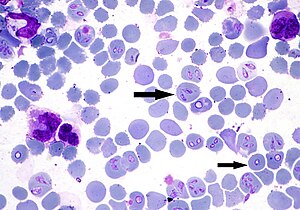Piroplasms
| Piroplasms | ||||||||||||
|---|---|---|---|---|---|---|---|---|---|---|---|---|

Babesia canis in the red blood cells of a dog |
||||||||||||
| Systematics | ||||||||||||
|
||||||||||||
| Scientific name | ||||||||||||
| Piroplasmorida | ||||||||||||
| Wenyon , 1926 |
Piroplasms ( piroplasmorida , syn. Piroplasmida , from Latin pirum , pear) are an order of unicellular parasites of red blood cells and white blood cells in mammals and birds that are transmitted by ticks. They belong to the Aconoidasida class .
The sexual reproduction ( gamogony ) of piroplasms takes place in the stomach of the tick (especially shield ticks , a type also in leather ticks ). The sporogony also takes place in the tick, the sporozoites arise in their salivary glands. The transmission to vertebrates occurs through tick bites . Meronts , merozoites and gamonts occur in the blood of mammals and birds . The parasites occur directly in the cytoplasm of the host cell (without parasitic vacuoles) and cause the blood cells to decay during asexual reproduction. The diseases caused by piroplasms are known as piroplasmoses .
In the classical system, piroplasms are divided into two families: Babesiidae and Theileridae . More recent molecular genetic studies suggest a division into eight groups.
literature
- Dwight D. Bowman: Georgis' Parasitology for Veterinarians . Elsevier Health Sciences, 10th Edition, 2014, ISBN 9781455739882 , p. 110.
- Georg von Samson-Himmelstjerna, Horst Zahner, Johannes Eckert, Peter Deplazes: Textbook of parasitology for veterinary medicine . Georg Thieme, 2012, 3rd edition, ISBN 9783830412052 , p. 114.